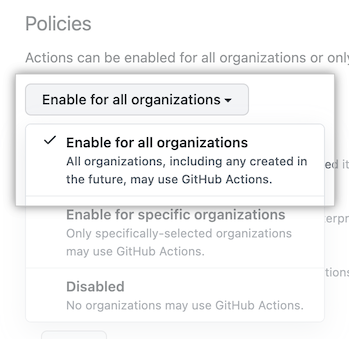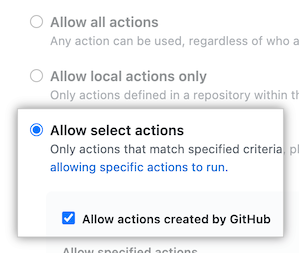About self-hosted runners for GitHub Actions
GitHub Actions allows people who use your GitHub Enterprise Server instance to improve productivity by automating every phase of the software development workflow. For more information, see "About GitHub Actions for enterprises."
With GitHub Actions, developers can write and combine individual tasks called actions to create custom workflows. To enable GitHub Actions for your GitHub Enterprise Server instance, you must host at least one machine to execute jobs. This machine is called a self-hosted runner. セルフホステッド ランナーは、物理または仮想にでき、コンテナー内、オンプレミス、またはクラウドに配置できます。 ランナーマシンは、GitHub Actionsのセルフホストランナーアプリケーションを使ってGitHub Enterprise Serverに接続します。 Self-hosted runners can run Linux, Windows, or macOS. For more information, see "About self-hosted runners."
This guide shows you how to apply a centralized management approach to self-hosted runners for GitHub Actions in your enterprise. In the guide, you'll complete the following tasks.
- Configure a limited policy to restrict the actions that can run within your enterprise
- Deploy a self-hosted runner for your enterprise
- Create a group to manage access to the runners available to your enterprise
- Optionally, further restrict the repositories that can use the runner
You'll also find additional information about how to monitor and secure your self-hosted runners, how to access actions from GitHub.com, and how to customize the software on your runner machines.
After you finish the guide, users of your GitHub Enterprise Server instance will be able to run workflow jobs from GitHub Actions on a self-hosted runner machine.
Prerequisites
-
GitHub Actions は、GitHub Enterprise Server に対して有効にする必要があります。 サイト管理者は、インスタンスの GitHub Actions を有効にして構成できます。 詳細については、「GitHub Enterprise Server の GitHub Actions の概要」を参照してく� さい。
-
環境内でセルフホステッド ランナーとして使用するマシンにアクセスできる必要があります。
-
The connection between self-hosted runners and GitHub Enterprise Server is over HTTP (port 80) or HTTPS (port 443). To ensure connectivity over HTTPS, configure TLS for your GitHub Enterprise Server instance. For more information, see "Configuring TLS." 詳細については、「セルフホステッド ランナーについて」を参照してく� さい。
-
Your enterprise must own at least one organization. For more information, see "About organizations" and "Creating a new organization from scratch."
1. Configure policies for GitHub Actions
First, enable GitHub Actions for all organizations, and configure a policy to restrict the actions that can run on your GitHub Enterprise Server instance. Optionally, organization owners can further restrict these policies for each organization.
-
GitHub Enterprise Server の右上で、ご自分のプロファイル写真をクリックしてから、 [Enterprise 設定] をクリックします。
![GitHub Enterprise Server のプロファイル写真のドロップダウン メニューの [自分の Enterprise]](https://githubdocs.azureedge.net/enterprise/3.2/assets/cb-35568/images/enterprise/settings/enterprise-settings.png)
-
Enterprise サイドバーで、 [ポリシー] をクリックします。
![[Enterprise アカウント] サイドバーの [ポリシー] タブ](https://githubdocs.azureedge.net/enterprise/3.2/assets/cb-14282/images/help/business-accounts/enterprise-account-policies-tab.png)
-
[ ポリシー] で、 [アクション] をクリックします。
-
Under "Policies", select Enable for all organizations.

-
Select [Allow select actions](選択したアクションを許可する) and Allow actions created by GitHub to allow local actions, and actions created by GitHub.

-
Click Save.
You can configure additional policies to restrict the actions available to users of your GitHub Enterprise Server instance. For more information, see "Enforcing policies for GitHub Actions in your enterprise."
2. Deploy the self-hosted runner for your enterprise
Next, add a self-hosted runner to your enterprise. GitHub Enterprise Server will guide you through installation of the necessary software on the runner machine. After you deploy the runner, you can verify connectivity between the runner machine and your GitHub Enterprise Server instance.
Adding the self-hosted runner
To add a self-hosted runner to an enterprise, you must be an enterprise owner.
-
GitHub Enterprise Server の右上で、ご自分のプロファイル写真をクリックしてから、 [Enterprise 設定] をクリックします。
![GitHub Enterprise Server のプロファイル写真のドロップダウン メニューの [自分の Enterprise]](https://githubdocs.azureedge.net/enterprise/3.2/assets/cb-35568/images/enterprise/settings/enterprise-settings.png)
-
Enterprise サイドバーで、 [ポリシー] をクリックします。
![[Enterprise アカウント] サイドバーの [ポリシー] タブ](https://githubdocs.azureedge.net/enterprise/3.2/assets/cb-14282/images/help/business-accounts/enterprise-account-policies-tab.png)
-
[ ポリシー] で、 [アクション] をクリックします。
-
[Runners](ランナー) タブをクリックします。
-
Click Add new, then click New runner.
-
使用するセルフホスト ランナー マシンのオペレーティング システ� イメージとアーキテクチャを選択します。
-
ランナーアプリケーションをダウンロードして、使用するセルフホストランナーのマシンにインストールする方法が表示されます。
セルフホストランナーのマシンでシェルを開き、表示� �に従ってシェルコマンドを実行してく� さい。
注: Windows で、セルフホスト ランナー アプリケーションをサービスとしてインストールする� �合は、シェルを管理者権限でオープンしなければなりません。 また、
C:\actions-runnerをセルフホスト ランナー アプリケーション用のディレクトリとして使用し、Windows のシステ� アカウントでランナー ディレクトリにアクセスできるようにすることをお勧めします。この指示に従えば、以下のタスクが完了します。
- セルフホストランナーアプリケーションのダウンロードと展開。
configスクリプトを実行してセルフホスト ランナー アプリケーションを設定し、GitHub Actions に登録します。configスクリプトには、登録先の URL と、リクエストを認証してもらうための自動的に生成された時間制限付きのトークンが必要です。- Windows では、
configスクリプトからセルフホスト ランナーをサービスとしてインストールするかどうかも尋ねられます。 LinuxとmacOSでは、ランナーの追� を終えた後にサービスをインストールできます。 詳細については、「セルフホスト ランナー アプリケーションをサービスとして構成する」を参照してく� さい。
- Windows では、
- セルフホストランナーアプリケーションを実行して、マシンをGitHub Actionsに接続します。
Checking that your self-hosted runner was successfully added
After completing the steps to add a self-hosted runner, the runner and its status are now listed under "Self-hosted runners".
The self-hosted runner application must be active for the runner to accept jobs. When the runner application is connected to GitHub Enterprise Server and ready to receive jobs, you will see the following message on the machine's terminal.
√ Connected to GitHub
2019-10-24 05:45:56Z: Listening for Jobs3. Manage access to the self-hosted runner using a group
You can create a runner group to manage access to the runner that you added to your enterprise. You'll use the group to choose which organizations can execute jobs from GitHub Actions on the runner.
GitHub Enterprise Server adds all new runners to a group. Runners can be in one group at a time. By default, GitHub Enterprise Server adds new runners to the "Default" group.
-
GitHub Enterprise Server の右上で、ご自分のプロファイル写真をクリックしてから、 [Enterprise 設定] をクリックします。
![GitHub Enterprise Server のプロファイル写真のドロップダウン メニューの [自分の Enterprise]](https://githubdocs.azureedge.net/enterprise/3.2/assets/cb-35568/images/enterprise/settings/enterprise-settings.png)
-
Enterprise サイドバーで、 [ポリシー] をクリックします。
![[Enterprise アカウント] サイドバーの [ポリシー] タブ](https://githubdocs.azureedge.net/enterprise/3.2/assets/cb-14282/images/help/business-accounts/enterprise-account-policies-tab.png)
-
[ ポリシー] で、 [アクション] をクリックします。
-
[Runners](ランナー) タブをクリックします。
-
Use the Add new drop-down, and select New group.
-
Under "Group name", type a name for your runner group.
-
To choose a policy for organization access, under "Organization access", select the Organization access drop-down, and click Selected organizations.
-
To the right of the drop-down with the organization access policy, click .
-
Select the organizations you'd like to grant access to the runner group.
-
Optionally, to allow public repositories in the selected organizations to use runners in the group, select Allow public repositories.
Warning:
セルフホストランナーは、プライベートリポジトリでのみ利用することをおすすめします。 これは、ワークフロー内でコードを実行する pull request を作成することで、パブリック リポジトリのフォークによって、セルフホステッド ランナー マシン上で危険なコードが実行される可能性があるからです。
For more information, see "About self-hosted runners."
-
Click Save group to create the group and apply the policy.
-
To the right of "Default", click the number of runners in the group to show the runners.
-
Select the runner that you deployed.
-
To the right of "Runner groups", select the Move to group dropdown, and click the group that you previously created.
You've now deployed a self-hosted runner that can run jobs from GitHub Actions within the organizations that you specified.
4. Further restrict access to the self-hosted runner
Optionally, organization owners can further restrict the access policy of the runner group that you created. For example, an organization owner could allow only certain repositories in the organization to use the runner group.
For more information, see "Managing access to self-hosted runners using groups."
Next steps
-
You can monitor self-hosted runners and troubleshoot common issues. For more information, see "Monitoring and troubleshooting self-hosted runners."
-
GitHub recommends that you review security considerations for self-hosted runner machines. For more information, see "Security hardening for GitHub Actions."
-
You can manually sync repositories on GitHub.com containing actions to your enterprise on GitHub Enterprise Server. Alternatively, you can allow members of your enterprise to automatically access actions from GitHub.com by using GitHub Connect. For more information, see the following.
-
You can customize the software available on your self-hosted runner machines, or configure your runners to run software similar to GitHub-hosted runners available for customers using GitHub.com. The software that powers runner machines for GitHub Actions is open source. For more information, see the
actions/runnerandactions/runner-imagesrepositories.